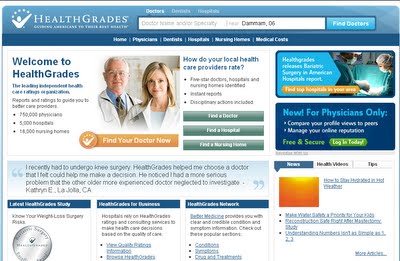Millions of Americans read physician ratings on websites such as Healthgrades.com, but such ratings are based on scores from an average of only 2.4 patients, a Loyola University Medical Center study has found.
The study of 500 randomly selected urologists found that 79.6 percent of physicians were rated by at least one of the 10 free physician-review websites researchers examined. Eighty-six percent of physicians had positive ratings, with 36 percent receiving highly positive ratings. Healthgrades had the most physician ratings. Results were published online ahead of print in the Journal of Urology.
 “Consumers should be cautious when they look at these ratings,” said first author Chandy Ellimoottil, MD. “Our findings suggest that consumers should take these ratings with a grain of salt.”
“Consumers should be cautious when they look at these ratings,” said first author Chandy Ellimoottil, MD. “Our findings suggest that consumers should take these ratings with a grain of salt.”
Ellimoottil explained that because physicians typically receive so few ratings, a highly negative or highly positive score from just one or two patients could skew the physician’s rating. “These sites have potential to help inform consumers,” Ellimoottil said. “But the sites need more reviews to make them more reliable.”
Half of Americans who go online for health information look up their providers and 40 percent use physician-review websites. But there have been few studies about such websites.
Ellimoottil, senior author Ahmer Farooq, DO and colleagues randomly selected 500 of the nation’s 9,940 urologists for inclusion in the study, including 471 male and 29 female urologists from 39 states. On each website, the number of reviews per physician ranged from zero to 64, with the average 2.4.
Researchers found no statistically significant difference in the median number of reviews when gender, region and city size were compared.
Healthgrades posted reviews on 54 percent of physicians, followed in order by Vitals.com, 45 percent of physicians; Avvo.com, 39 percent; RateMDs.com, 25 percent; Drscore, 13 percent; Revolutionhealth.com, 5 percent; Kudzu.com and Healthcarereviews.com, 1 percent; and Zocdoc.com and Yelp.com, less than 1 percent.
Researchers also conducted a qualitative analysis of written comments posted on a single website, Vitals.com. Comments were rated extremely negative (such as “He needs to retire as he can barely walk”); negative; neutral; positive; or extremely positive (such as “One of the best checkups in a long time!!”). Three percent of these written comments were extremely negative, 22 percent were negative, 22 percent were neutral, 39 percent were positive and 14 percent were extremely positive.

